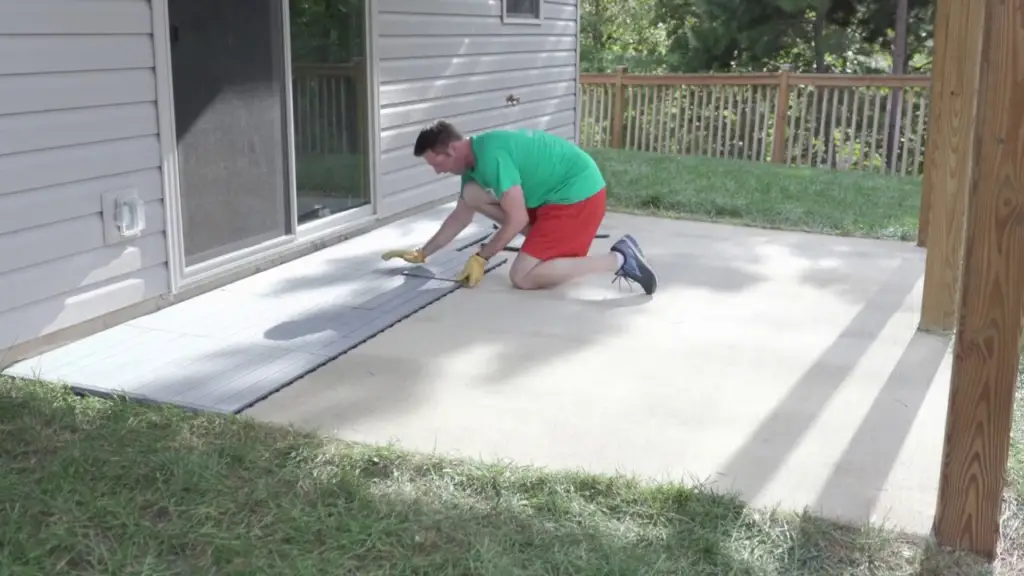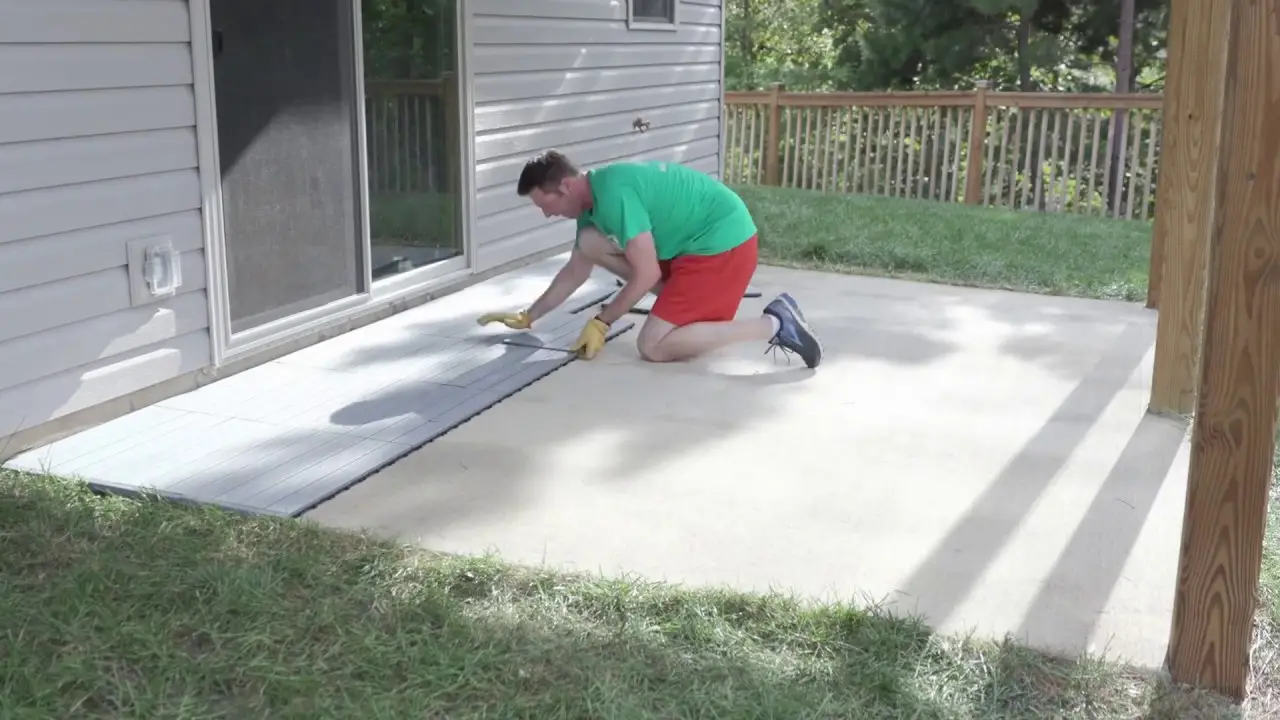Sure, Yes! You can put composite decking on concrete. In fact, concrete floors and patios are best to take deck tiles. They’re long-lasting and are strong enough to provide a stable surface for the composite decking. Other options like gravel or sand are not ideal in terms of stability and durability to take composite decking.
Let’s now delve deep and see if you can put decking directly onto concrete and if so, how?
While you’re searching for the best base for composite decking; you’ll find options like sand and gravel. But a lot of homeowners won’t know that they can put decking directly onto the concrete. Obviously you need to consult our local building office for any compliance issue. But in terms of structural point of view, there’s now issue in putting the deck on concrete.

Benefits of putting composite deck tiles directly on concrete
Here’s why we recommend installing decking directly on concrete instead of putting over dirt or grass.
- Additional stability – Yes, with concrete as base, the decking can get increase stability. There’ll be less movement overall and so the failure will not be imminent.
- Installation is quick – As you won’t need to use sub-frame and so it cuts the installation time in half.
- Hide old surface concrete – The deck can easily hide your old thud concrete; giving you an overall good appearance. So, if you concrete patio is cracked, discolored, or is showing some signs of wear and tear; it’s the best time to cover it with decking instead of removing or re-pouring the concrete.
- Rework and refresh your space with affordability – You won’t need to break bank to refresh your outdoor space. So, if you’re looking to enlist your property for sale; putting composite decking is a practical choice.
- Maintenance is easy: Concrete patios need frequent maintenance and rework. But with composite decking going directly on top, there’s no need to repair, repaint, or refinish cracked or discolored concrete.
- No weeds under your tiles – You can’t hate enough the weeds or plants sprouting from under your tiles. So, while you don’t have a grass underneath; the concrete won’t let such annoyance disturb you.
What are some requirements for concrete to take decking?
- Concrete must be stable – Your composite decking needs a stable base. This flexible and expansive material can otherwise move, warp, and eventually fail. So, a stable base is pretty crucial including properly constructed deck frame and resting on solid material.
- It must be free of cracks or distress – For the concrete to take the decking, it is important that no crack or distress is visible. A damaged concrete pad will eventually result in trouble overall.
Unlike traditional wood decking, composite decking is more bulky and needs robust base to support the additional weight. So, a poorly constructed deck or unstable base can lead to accidents and injuries.
Tools you need
Tools You Will Need
Before you begin the installation process, you will require several tools. These may include:
- Tape measure
- Chalk line
- Circular saw with composite deck blade
- Drill
- Concrete anchors
- Composite deck screws
- Hammer drill
- Masonry bit
- Safety goggles Earplugs Dust mask Level
- Rubber mallet
Also Read: Concrete Yards Calculator – How Many yards of concrete do I need?
Selecting Deck Tiles
Selecting the ideal decking tiles is an integral step in the installation process. Choose tiles made of high-quality materials like recycled plastic or composite tiles, and take into account their size and style to fit with the overall aesthetic of your outdoor space. Furthermore, opt for tiles designed specifically for outdoor use that resist moisture, UV rays, and other weather related conditions.
Like Us on Facebook!
Also Read: Can you paint concrete pavers? (Including Staining)
Subscribe Us on YouTube!
Preparing the Surface
The next step is to prepare the area where you plan to lay composite decking tiles. Start by cleaning the concrete floor thoroughly to eliminate any dirt or debris. You can do this with either a pressure washer or stiff-bristled brush.
Once the surface is clean, let it air-dry completely. A leaf blower can help expedite this process if desired. Ultimately, make sure the surface is completely dry before beginning installation.
Also Read: How to stop concrete from sweating? (Reasons & Tips to avoid)
Safety Precautions
Safety should always be your top priority when working with power tools and heavy materials. Before beginning any project, be sure to don safety goggles, earplugs, and a dust mask for protection from flying debris and particles.
Furthermore, make sure the area is free from any obstacles or potential tripping hazards. If possible, enlist the assistance of a friend or family member to assist with installation.
Also Read: Does concrete expand when it dries?
Measure Dimensions
Once the surface is dry and clean, you can begin measuring the dimensions of the area where you plan to lay composite decking tiles. Use a tape measure or chalk line to mark off your perimeter.
Begin by measuring the length and width of your space, then calculating its square footage. This will help you decide how many composite decking tiles you need for installation.
Also Read: Does WD40 stain concrete?
Laying Tiles
Now it is time to lay the composite decking tiles. Start by positioning the tiles in a corner of your space, and work your way outward. Make sure all of your tiles are lined up correctly and evenly spaced.
To secure the tiles in place, you will need concrete anchors and composite deck screws. You can use a hammer drill with a masonry bit to drill holes in the concrete floor where you will insert the anchors.
Once the anchors are set, you can use composite deck screws to fasten the tiles onto them. Make sure you use a level to guarantee evenness across all tiles and no uneven spots.
Cut Tiles as Necessary
As you near the edges of the space, it may be necessary to cut composite decking tiles to size. A circular saw and blade can be used for this task; just be sure to measure accurately beforehand so everything fits correctly.
Also Read: Difference between Marble and Ceramic Tiles
Install Trims
After all the composite decking tiles have been installed, you can add trims to the edges for a professional touch. Trims help conceal any exposed edges between tiles and provide an even aesthetic across your installation.
Installing trims can be done using a saw to cut them to size, then secure them in place with composite deck screws. Be sure to measure accurately before cutting to ensure an exact fit.
Maintenance and Care
Composite decking is known for its low upkeep needs, but it still needs some attention to ensure its longevity. You should clean the decking regularly to remove dirt, debris or stains using a composite deck cleaner and soft-bristled brush.
Additionally, you should inspect the decking periodically for any signs of damage or wear. If you spot any issues like cracks, warping, or fading, take immediate steps to remedy them and avoid further destruction.
In what cases you should not put composite decking directly on concrete floor?
Here’re some reasons why putting decking directly on concrete is not an ideal choice:
- Not good for ventilation and structural integrity – Every decking material, especially composite decking require robust framework to support load, provide ventilation, and ensure structural integrity.
- Concrete may not be level: Concrete generally have volumetric changes i.e. it expands in winters and shrinks in summers. So, while concrete slab is not always level and so securing the boards directly would not be a good choice for the deck.
- Water buildup: The subframe for decking also protect the structure from issues like excessive water build-up. So, if you put directly on concrete; the deck product would deteriorate overtime causing trouble in the long run.



















